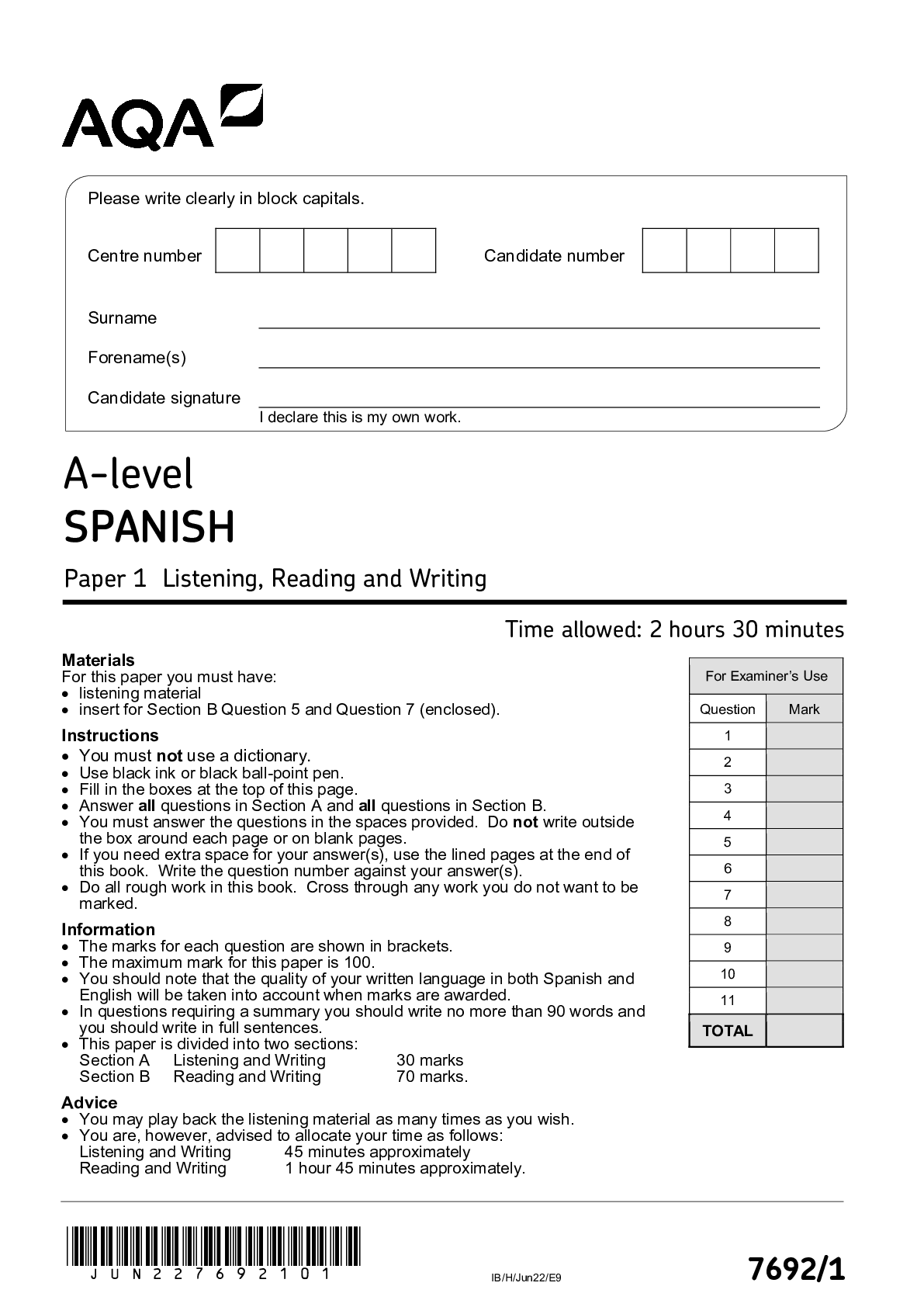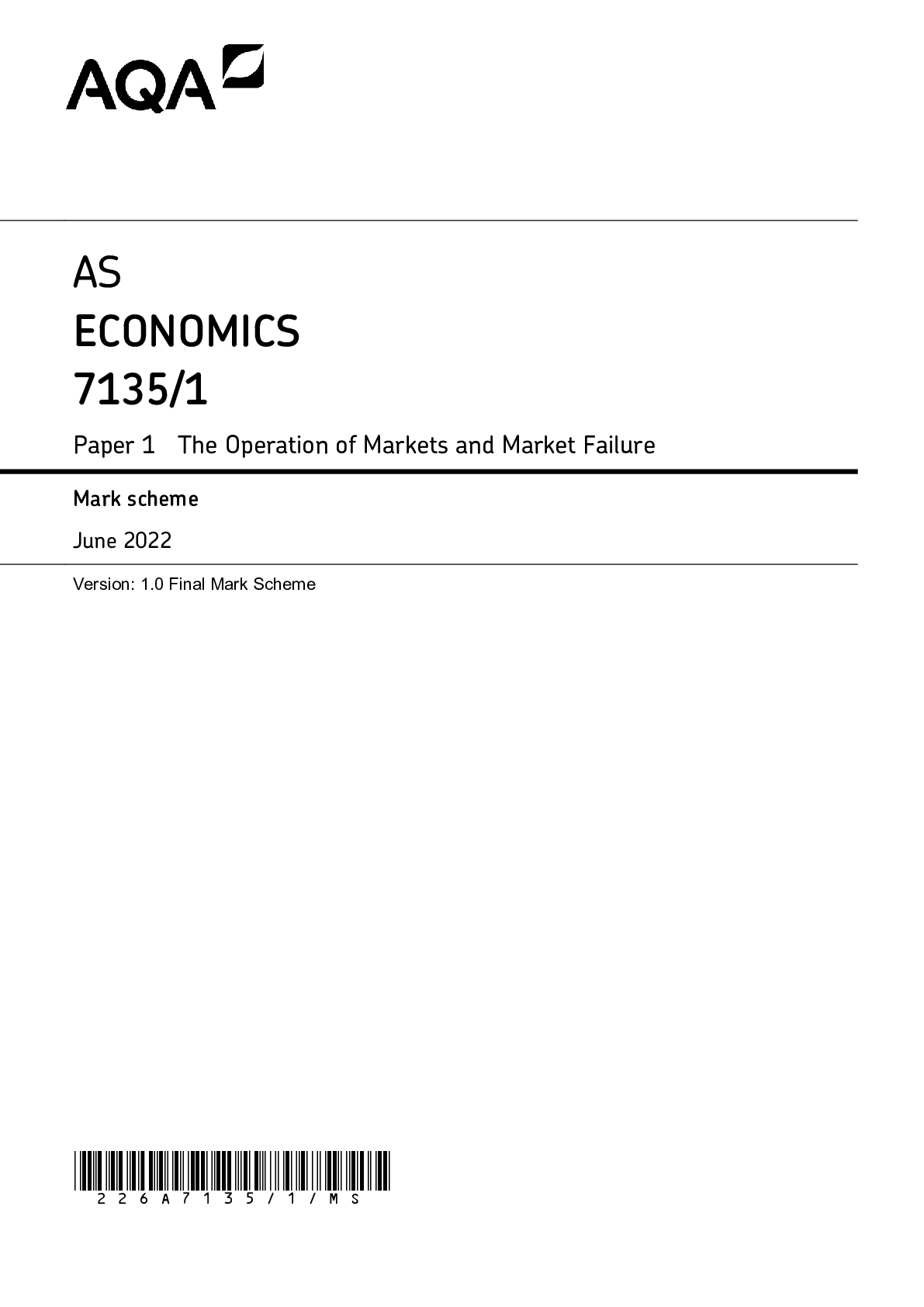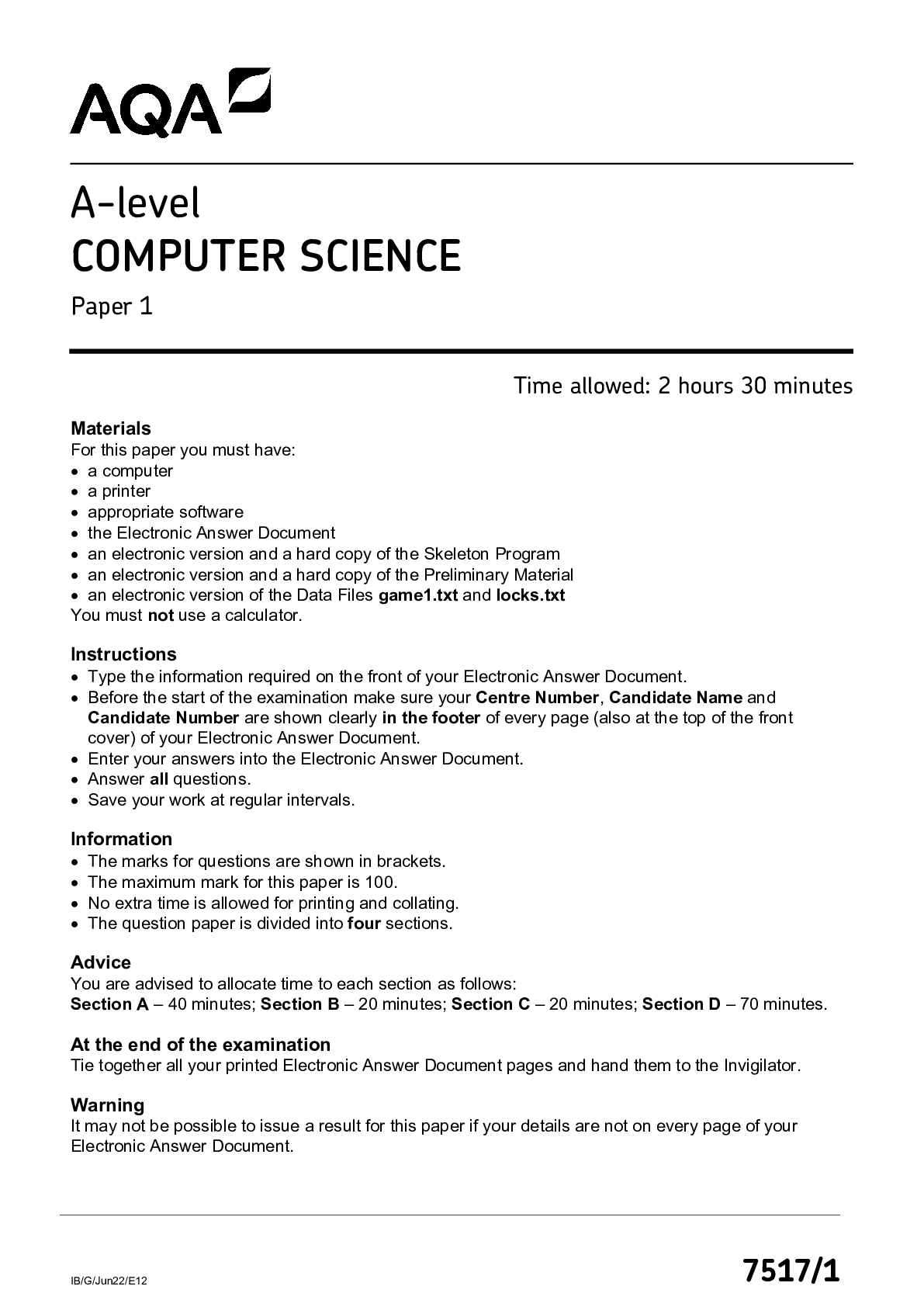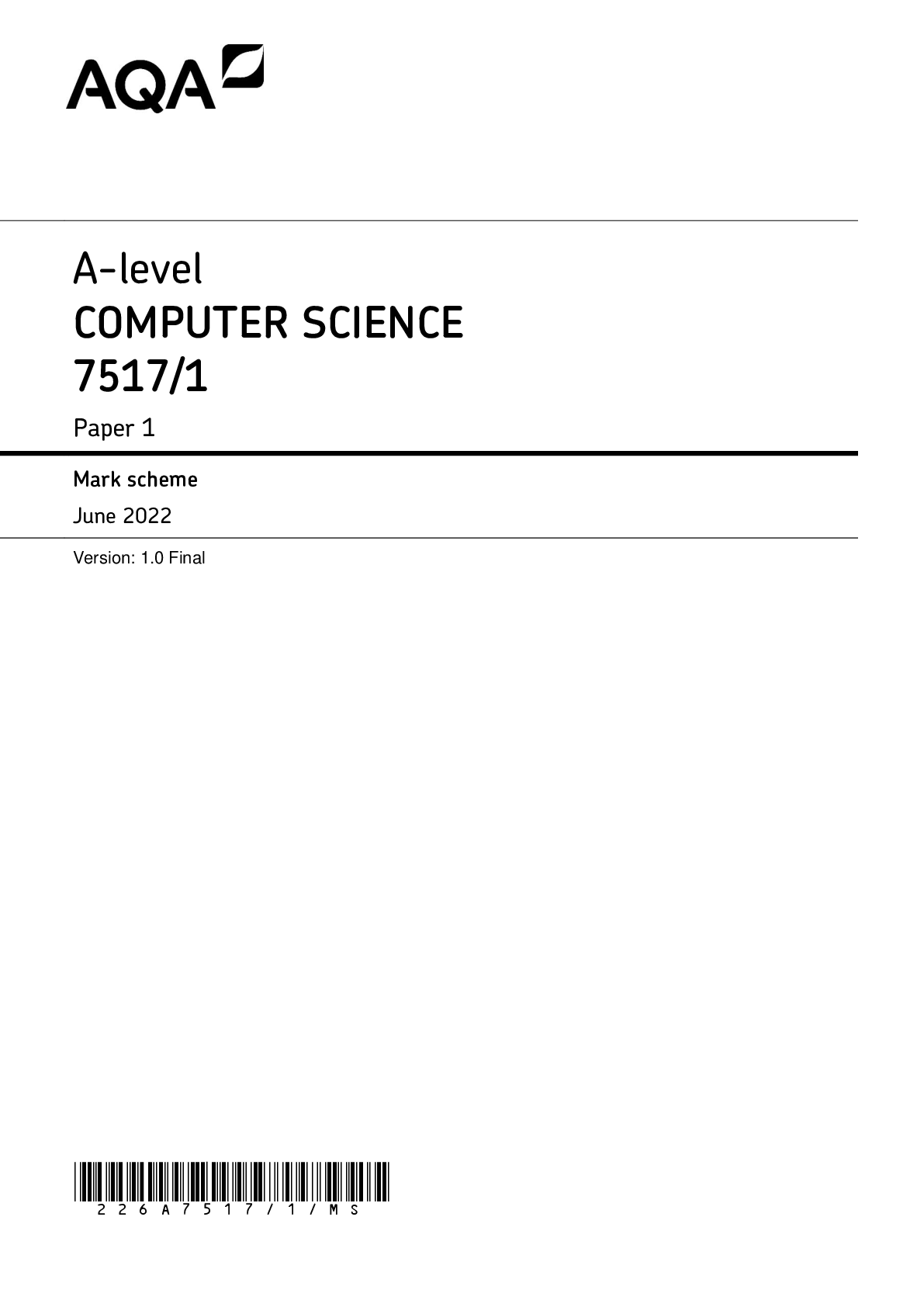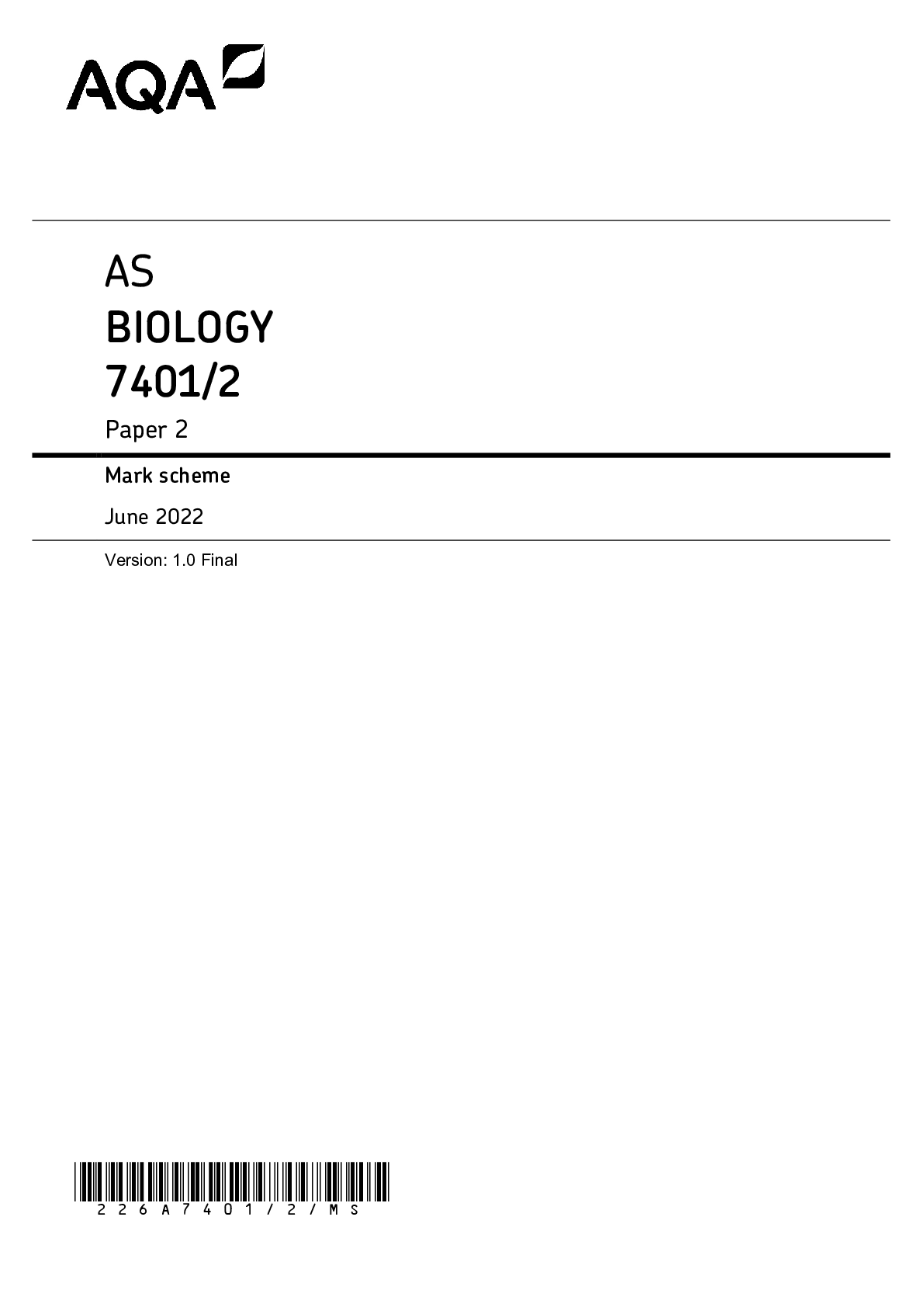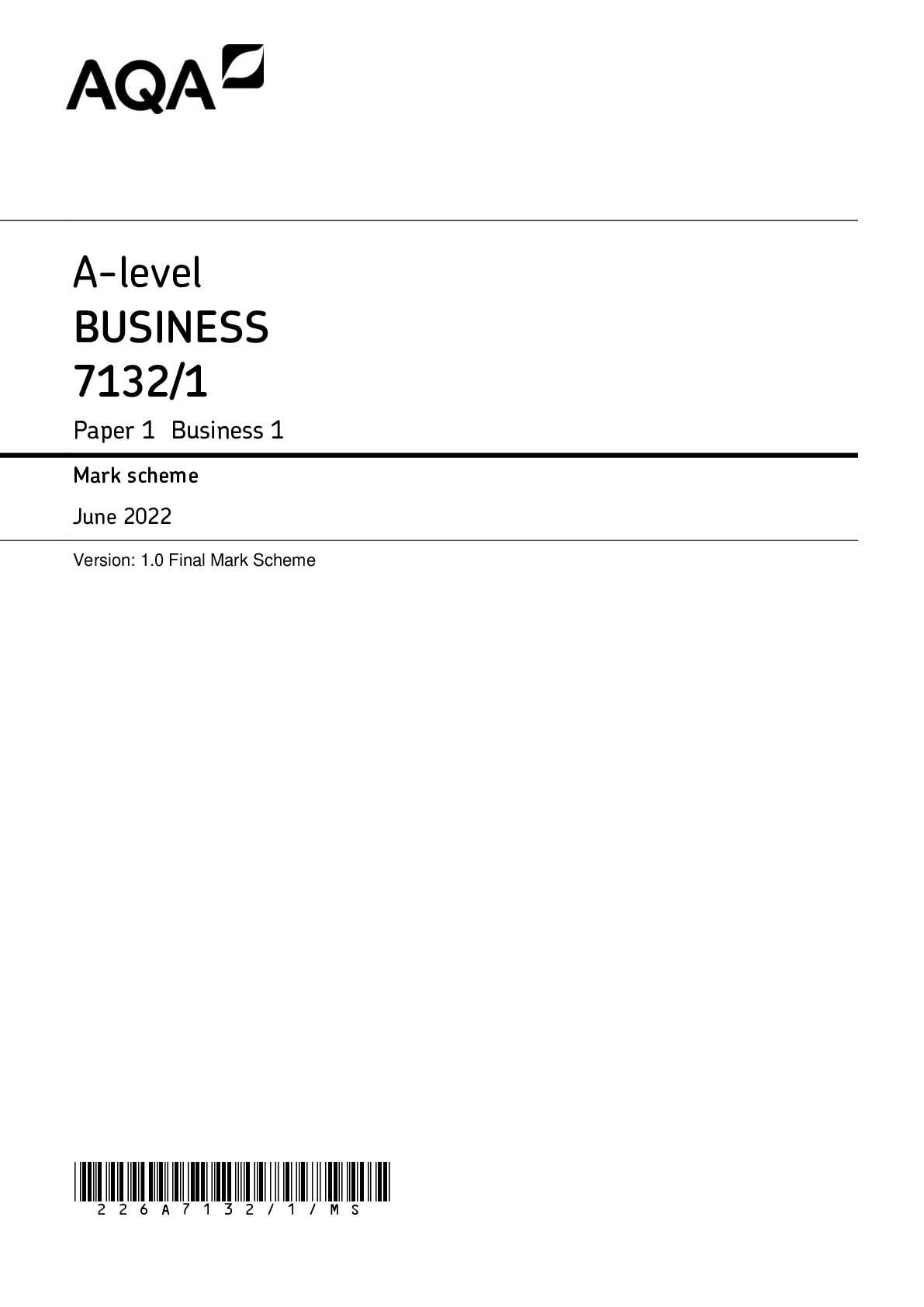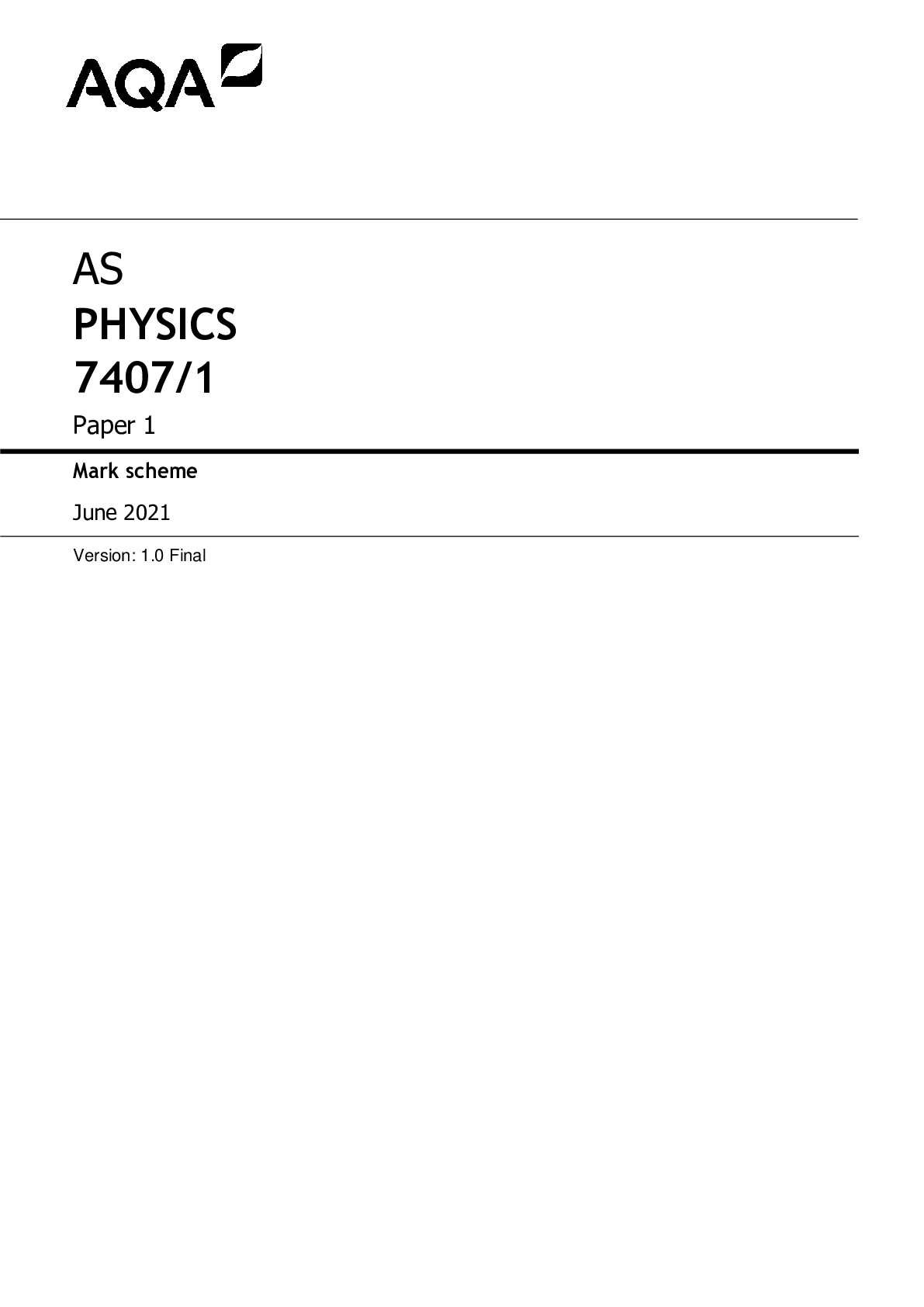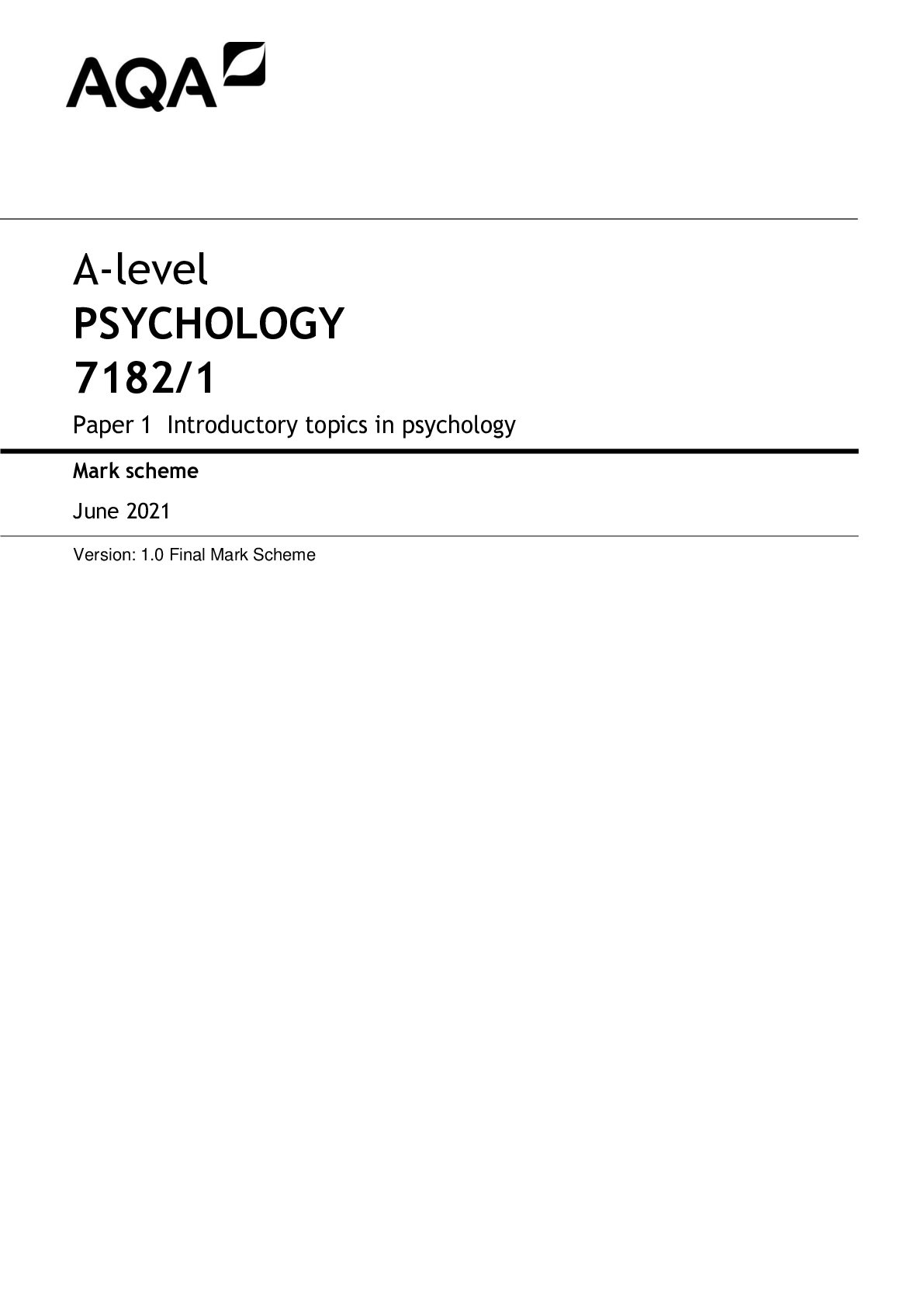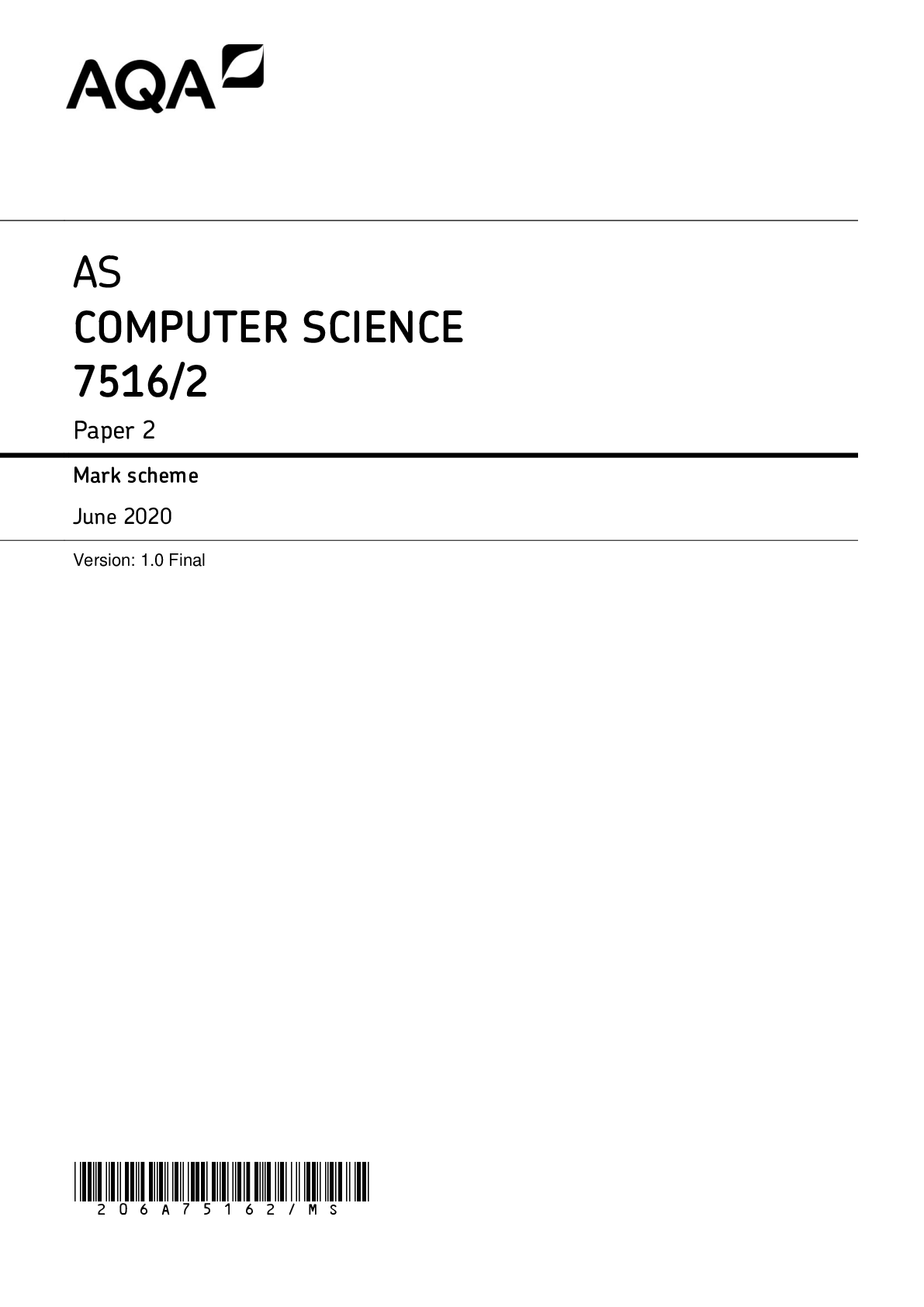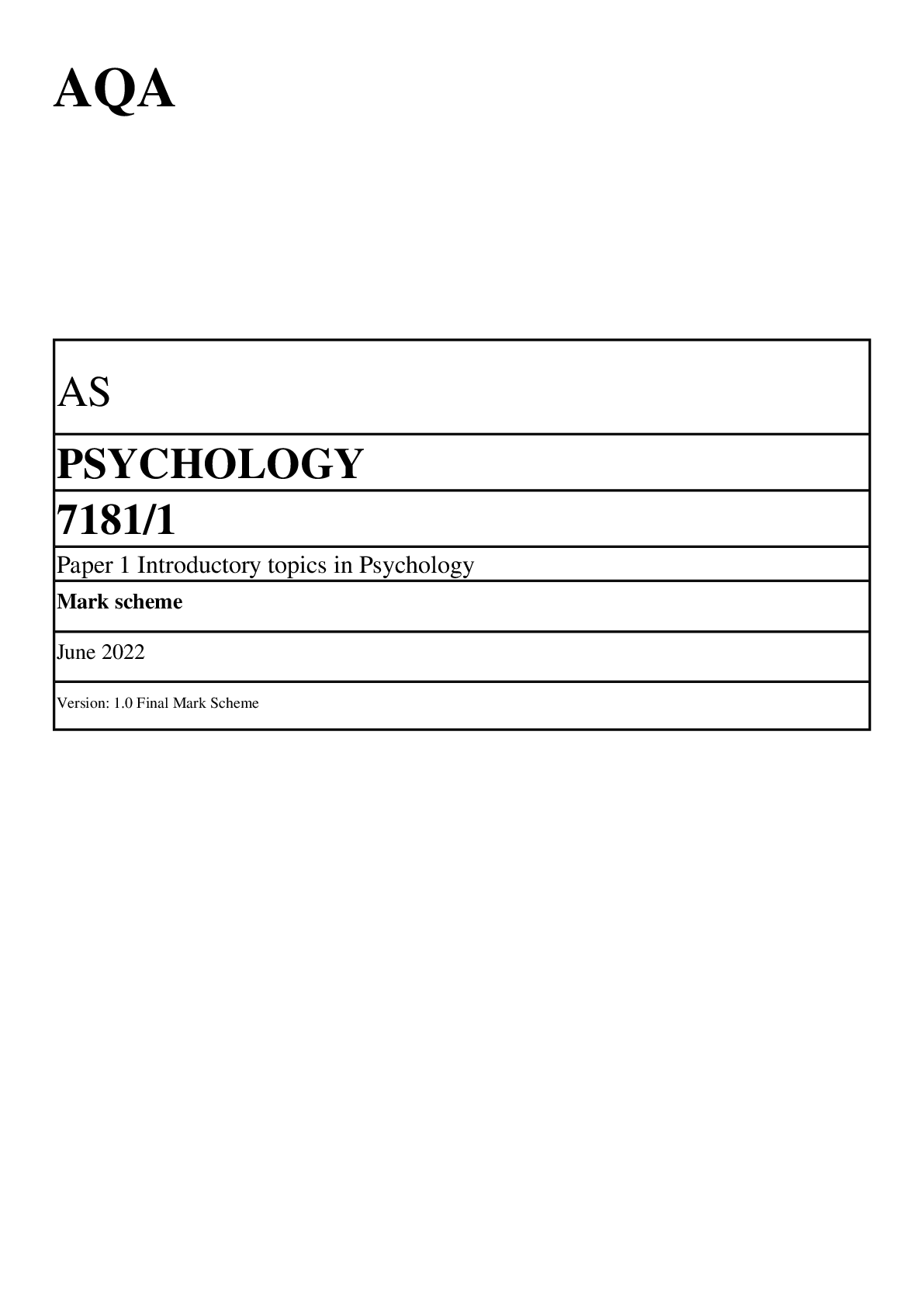Psychology > AS Level Mark Scheme > A-level PSYCHOLOGY 7182/3 Paper 3 Issues and options in psychology Mark scheme June 2022 Version: 1. (All)
A-level PSYCHOLOGY 7182/3 Paper 3 Issues and options in psychology Mark scheme June 2022 Version: 1.0 Final *Jun227182/3/MS* MARK SCHEME – A-LEVEL PSYCHOLOGY – 7182/3 – JUNE 2022 2
Document Content and Description Below
A-level PSYCHOLOGY 7182/3 Paper 3 Issues and options in psychology Mark scheme June 2022 Version: 1.0 Final *Jun227182/3/MS* MARK SCHEME – A-LEVEL PSYCHOLOGY – 7182/3 – JUNE 2022 2 Mar... k schemes are prepared by the Lead Assessment Writer and considered, together with the relevant questions, by a panel of subject teachers. This mark scheme includes any amendments made at the standardisation events which all associates participate in and is the scheme which was used by them in this examination. The standardisation process ensures that the mark scheme covers the students’ responses to questions and that every associate understands and applies it in the same correct way. As preparation for standardisation each associate analyses a number of students’ scripts. Alternative answers not already covered by the mark scheme are discussed and legislated for. If, after the standardisation process, associates encounter unusual answers which have not been raised they are required to refer these to the Lead Examiner. It must be stressed that a mark scheme is a working document, in many cases further developed and expanded on the basis of students’ reactions to a particular paper. Assumptions about future mark schemes on the basis of one year’s document should be avoided; whilst the guiding principles of assessment remain constant, details will change, depending on the content of a particular examination paper. Further copies of this mark scheme are available from aqa.org.uk Copyright information AQA retains the copyright on all its publications. However, registered schools/colleges for AQA are permitted to copy material from this booklet for their own internal use, with the following important exception: AQA cannot give permission to schools/colleges to photocopy any material that is acknowledged to a third party even for internal use within the centre. Copyright © 2022 AQA and its licensors. All rights reserved. MARK SCHEME – A-LEVEL PSYCHOLOGY – 7182/3 – JUNE 2022 3 Level of response marking instructions Level of response mark schemes are broken down into levels, each of which has a descriptor. The descriptor for the level shows the average performance for the level. There are marks in each level. Before you apply the mark scheme to a student’s answer read through the answer and annotate it (as instructed) to show the qualities that are being looked for. You can then apply the mark scheme. Step 1 Determine a level Start at the lowest level of the mark scheme and use it as a ladder to see whether the answer meets the descriptor for that level. The descriptor for the level indicates the different qualities that might be seen in the student’s answer for that level. If it meets the lowest level then go to the next one and decide if it meets this level, and so on, until you have a match between the level descriptor and the answer. With practice and familiarity you will find that for better answers you will be able to quickly skip through the lower levels of the mark scheme. When assigning a level you should look at the overall quality of the answer and not look to pick holes in small and specific parts of the answer where the student has not performed quite as well as the rest. If the answer covers different aspects of different levels of the mark scheme you should use a best fit approach for defining the level and then use the variability of the response to help decide the mark within the level, ie if the response is predominantly Level 3 with a small amount of Level 4 material it would be placed in Level 3 but be awarded a mark near the top of the level because of the Level 4 content. Step 2 Determine a mark Once you have assigned a level you need to decide on the mark. The descriptors on how to allocate marks can help with this. The exemplar materials used during standardisation will help. Answers in the standardising materials will correspond with the different levels of the mark scheme. These answers will have been awarded a mark by the Lead Examiner. You can compare the student’s answer with the standardised examples to determine if it is the same standard, better or worse than the example. You can then use this to allocate a mark for the answer based on the Lead Examiner’s mark on the example. You may well need to read back through the answer as you apply the mark scheme to clarify points and assure yourself that the level and the mark are appropriate. Indicative content in the mark scheme is provided as a guide for examiners. It is not intended to be exhaustive and you must credit other valid points. Students do not have to cover all of the points mentioned in the indicative content to reach the highest level of the mark scheme. An answer which contains nothing of relevance to the question must be awarded no marks. MARK SCHEME – A-LEVEL PSYCHOLOGY – 7182/3 – JUNE 2022 4 Section A Issues and debates in psychology 0 1 Outline what is meant by soft determinism. [2 marks] Marks for this question: AO1 = 2 2 marks for a clear and coherent outline with some elaboration. 1 mark for a limited or muddled outline. Content: • the idea that behaviour/actions/traits are to an extent governed/dictated by internal/external forces • despite this, we still have some element of control over/some free will to control our behaviour/actions/traits etc. Accept other relevant outlines and outlines embedded in example. 0 2 Explain two reasons why it was appropriate to use a Wilcoxon test in this situation. Refer to the description of the study in your answer. [4 marks] Marks for this question: AO2 = 4 For each of two valid reasons, award marks as follows: 2 marks for a clear and coherent reason. 1 mark for a limited/muddled reason. Reasons: • tested all participants both alone and in the presence of a friend therefore the psychologist used the same participants in each condition, thus the design was repeated measures/related • data were ratings of happiness on a ratings scale which would be considered ordinal data as the units can be ranked from high to low but are not of a fixed size/equal intervals • the psychologist was investigating a difference in happiness ratings between two conditions: the Alone Condition and the Friend Condition. MARK SCHEME – A-LEVEL PSYCHOLOGY – 7182/3 – JUNE 2022 5 0 3 What is meant by a causal explanation? Explain why it was appropriate to claim that there was a causal explanation in this case. [4 marks] Marks for this question: AO1 = 2, AO2 = 2 Level Marks Description 2 3–4 Knowledge of what is meant by a causal explanation is clear and detailed. The explanation of why it was appropriate in this case is clear and detailed and shows sound understanding. There is appropriate use of specialist terminology. 1 1–2 Knowledge of what is meant by a causal explanation is limited/muddled. Any explanation of why it was appropriate in this case lacks detail/understanding. Use of specialist terminology is either absent or inappropriate. 0 No relevant content. Content: • a causal explanation is based on the scientific notion that behaviour is caused/determined by internal/external factors – there is a cause and effect relationship Application: • the experiment was a controlled laboratory study so the only thing that changed was the IV (presence of friend or not), all other variables were controlled and there was a (significant) effect on the DV (happiness ratings). Credit other relevant material. MARK SCHEME – A-LEVEL PSYCHOLOGY – 7182/3 – JUNE 2022 6 0 4 Using an example of a research study you have learned about in psychology, outline what is meant by a nomothetic approach to psychological investigation. [4 marks] Marks for this question: AO1 = 4 Content: Up to 2 marks for knowledge of what is meant by a nomothetic approach. Award 1 mark for each of the following points: • a nomothetic approach involves studying a (large) sample of participants • using the findings to generate or substantiate general laws/models of behaviour; make inferences about the wider population/make generalisations; make predictions. Plus 2 marks for an appropriate research study (no need to name), with clear and coherent explanation of how findings from the sample have been used to generate a theory/applied to a larger population. OR 1 mark for a relevant research study with limited/muddled explanation. Suitable examples can be taken from any area of psychology, eg • Milgram tested a sample of participants to propose his theory of situational obedience • Ainsworth tested infants using the Strange Situation to propose three attachment types. Credit other relevant material/examples. MARK SCHEME – A-LEVEL PSYCHOLOGY – 7182/3 – JUNE 2022 7 0 5 Referring to the example used in your answer to Question 04, briefly explain how the same behaviour might be studied using an idiographic approach to psychological investigation. [2 marks] Marks for this question: AO3 = 2 Award 1 mark for an appropriate idiographic method eg the case study method, single-case observation, in-depth interview etc Plus 1 mark for how it could be used with this behaviour eg carrying out a case study of a mother and baby to study their unique attachment behaviours. Credit other relevant material. Note: for the 2nd mark the behaviour must be the same as that given in answer to Question 04 but not necessarily a variation of the same study eg if using Milgram in 04 the proposal should relate to obedience Note: If there is no answer to 04 or no behaviour is given in answer to 04, no credit can be awarded for 05 MARK SCHEME – A-LEVEL PSYCHOLOGY – 7182/3 – JUNE 2022 8 0 6 Outline what social sensitivity means in the context of psychology. Explain how researchers in psychology could deal with issues related to social sensitivity. [8 marks] Marks for this question: AO1 = 3, AO3 = 5 Level Marks Description 4 7–8 Outline of social sensitivity is accurate with some detail. Explanation of how researchers in psychology could deal with issues related to social sensitivity is thorough and effective. Minor detail and/or expansion of argument is sometimes lacking. The answer is clear, coherent and focused. Specialist terminology is used effectively. 3 5–6 Outline of social sensitivity is evident but there are occasional inaccuracies/omissions. Explanation of how researchers in psychology could deal with issues related to social sensitivity is mostly effective. The answer is mostly clear and organised but occasionally lacks focus. Specialist terminology is used appropriately. 2 3–4 Outline of social sensitivity is present. Focus is mainly on description. Any explanation of how researchers in psychology could deal with issues related to social sensitivity is of limited effectiveness. The answer lacks clarity, accuracy and organisation in places. Specialist terminology is used inappropriately on occasions. 1 1–2 Outline of social sensitivity is very limited. Explanation of how researchers in psychology could deal with issues related to social sensitivity is limited, poorly focused or absent. The answer as a whole lacks clarity, has many inaccuracies and is poorly organised. Specialist terminology is either absent or inappropriately used. 0 No relevant content. Possible content: • research which has potential implications or consequences, eg leading to prejudice and discrimination • where a group of people represented in the research might be negatively affected as a result of a study, eg women affected by Bowlby’s work on attachment • where a study leads to changes in public policy affecting individuals/groups, eg research into IQ in the 1950s leading to educational changes. Possible explanation points: • submit research proposals to ethics committees and abide by any recommendations • weigh up the possible costs and benefits before conducting any research. Only proceed where the benefits (to many) outweigh the costs (to a few) • take care when formulating the aim/framing the question so as not to misrepresent certain groups • be alert to the possibility of misuse of findings and take steps to present findings in a value-free way • consider the wider effects of publication of the findings eg Sieber and Stanley’s recommendations as part of the peer review process • take steps to avoid prejudicial/biased/sensational media presentation of findings • consider the possible reactions of participants to any research procedure they experience and take account of ethical issues in the design of any studies • use of examples to illustrate specific ways in which social sensitivity can be taken into account. Credit other relevant material. MARK SCHEME – A-LEVEL PSYCHOLOGY – 7182/3 – JUNE 2022 9 Section B Relationships 0 7 Use your knowledge of theories of romantic relationships to explain the comments made by Chris and Sam. [8 marks] Marks for this question: AO2 = 8 Level Marks Description 4 7–8 Application of knowledge of theories of romantic relationships is detailed and effective. The answer is clear, coherent and focused. Specialist terminology is used effectively. 3 5–6 Application of knowledge of theories of romantic relationships is evident and mostly effective. The answer is mostly clear and organised but occasionally lacks focus. Specialist terminology is used appropriately. 2 3–4 Application of knowledge of theories of romantic relationships is present but of limited effectiveness. The answer lacks clarity, accuracy and organisation in places. Specialist terminology is used inappropriately on occasions. 1 1–2 Application of knowledge of theories of romantic relationships is limited, poorly focused or absent. The answer as a whole lacks clarity, has many inaccuracies and is poorly organised. Specialist terminology is either absent or inappropriately used. Answers without explicit application [Show More]
Last updated: 1 year ago
Preview 1 out of 43 pages

Reviews( 0 )
Document information
Connected school, study & course
About the document
Uploaded On
Apr 01, 2023
Number of pages
43
Written in
Additional information
This document has been written for:
Uploaded
Apr 01, 2023
Downloads
0
Views
89


